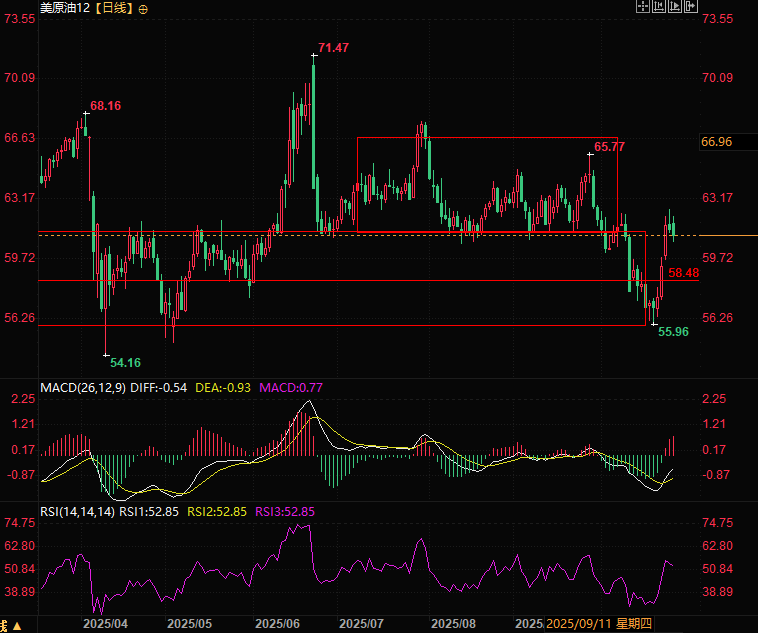Are layoffs just the beginning? Wall Street warns: The biggest shift in the oil market has quietly begun.
2025-10-27 18:36:49
There is a hidden thread behind the rapid rise in actual crude oil prices, that is, the drop in oil prices has caused a large-scale shrinkage of shale oil companies, which is beneficial to oil prices in the long run.
The emergence of rock oil has completely reshaped the supply and demand pattern, pricing logic and competition structure of the global crude oil market, fundamentally breaking the "monopoly supply" model previously dominated by OPEC (Organization of Petroleum Exporting Countries).
It should also be pointed out that shale oil investment is very sensitive to oil prices. Some studies have shown that the oil price must exceed 65 to reach the break-even point for new wells, that is, the shale oil production capacity that has been cleared out will be difficult to add back in the short term.

Oil prices fall in 2025, and oil companies start cost defense mode
Crude oil prices in 2025 will be significantly lower than in 2024, a key variable that will directly trigger cost-cutting strategies by US oil and gas producers. For the crude oil trading market, falling prices not only squeeze profit margins for oil companies but also push the industry from expansion to defense. Layoffs and cost reductions have become key responses for leading companies to market changes. By streamlining staff and optimizing efficiency, they are mitigating the performance pressure brought on by falling oil prices. This trend also provides traders with important insights into the industry's economic outlook.
After the wave of mergers and acquisitions in 2023-2024, integration and streamlining will become inevitable
Before the layoffs began, the U.S. shale region had completed a round of large-scale mergers and acquisitions: between 2023 and 2024, leading oil companies completed multi-billion dollar transactions one after another - ConocoPhillips acquired Marathon Oil for US$22.5 billion (including debt), Chevron acquired Hess Corporation for US$53 billion, and ExxonMobil acquired Pioneer Natural Resources for US$60 billion.
From the perspective of crude oil trading, the core logic of mergers and acquisitions is to expand scale and diversify shale basin risks. However, these mergers and acquisitions inevitably face the problems of business overlap and redundant positions. With the decline in oil prices in 2025, "consolidation and streamlining" will shift from an optional move to a mandatory one, shifting the industry from a "period of expansion through mergers and acquisitions" to a "period of optimization and contraction." This cyclical shift will directly impact market expectations for crude oil supply.
Details of layoffs at major oil companies: Scale and scope exceed expectations, with North America as the core
The US shale region is experiencing its worst wave of layoffs in three years, with an overall "global linkage and regional focus" trend. This has a direct impact on crude oil trading targets (company stocks and shale oil derivatives). Specific corporate actions are as follows:
ConocoPhillips: Plans to cut 25% of global employees, with a focus on Canadian operations (currently 950 employees), with notice to start in November 2025, which will affect Canada's shale oil production capacity and regional supply.
Chevron: Global employees will be cut by 15%-20% by the end of 2026, and 800 jobs will be cut in the Permian Basin (the core shale oil production area in the United States), which may drag down local drilling volume and crude oil production.
ExxonMobil: 2,000 layoffs worldwide, with a focus on Canada (subsidiary Imperial Oil) and Texas, USA (400 jobs have been cut), which will affect the production capacity of the two places and the flow of cross-regional crude oil trade.
In addition to US companies, British Petroleum (BP) has also joined the cost-cutting movement. Under pressure from shareholders to reduce costs and debt, BP has accelerated cuts in contractors and office staff: 3,200 contractors have been eliminated so far, with an additional 1,200 planned by the end of 2025. Cumulative cost savings from supply chain optimization have reached $900 million, with over a third of these savings coming from contractor reductions. This move reflects that oil companies' cost-cutting efforts have extended into the supply chain, potentially indirectly impacting oilfield service efficiency and, in turn, crude oil production.
Summarize:
In the previous article on oil prices, I wrote about the deduction that capacity clearance would be beneficial to oil prices. At that time, oil prices were at the bottom of the box, and it happened that the geopolitical crisis had caused oil prices to rise continuously recently.
From the core logic of "capacity clearance → supply contraction → oil price boost", the large-scale layoffs of US shale giants and BP are not simply cost defense measures, but also contain key clues to the reconstruction of the supply side of the crude oil market. Although suppressed by the inertia of falling oil prices in the short term, the cumulative effect of medium-term capacity contraction will gradually emerge, which may provide clear long-term logical support for crude oil trading.
Technical Analysis:
The upper edge of the box is a very cost-effective profit-taking point and is also an important pressure point in the near future. Since the oil price rebounded very quickly this time, if the oil price can stabilize and fluctuate near the upper edge of the box, the oil price may continue to rise in the later period.

(Daily chart of the December crude oil futures contract, source: Yihuitong)
At 18:35 Beijing time, the December futures contract of US crude oil was trading at US$60.90 per barrel.
- Risk Warning and Disclaimer
- The market involves risk, and trading may not be suitable for all investors. This article is for reference only and does not constitute personal investment advice, nor does it take into account certain users’ specific investment objectives, financial situation, or other needs. Any investment decisions made based on this information are at your own risk.





















